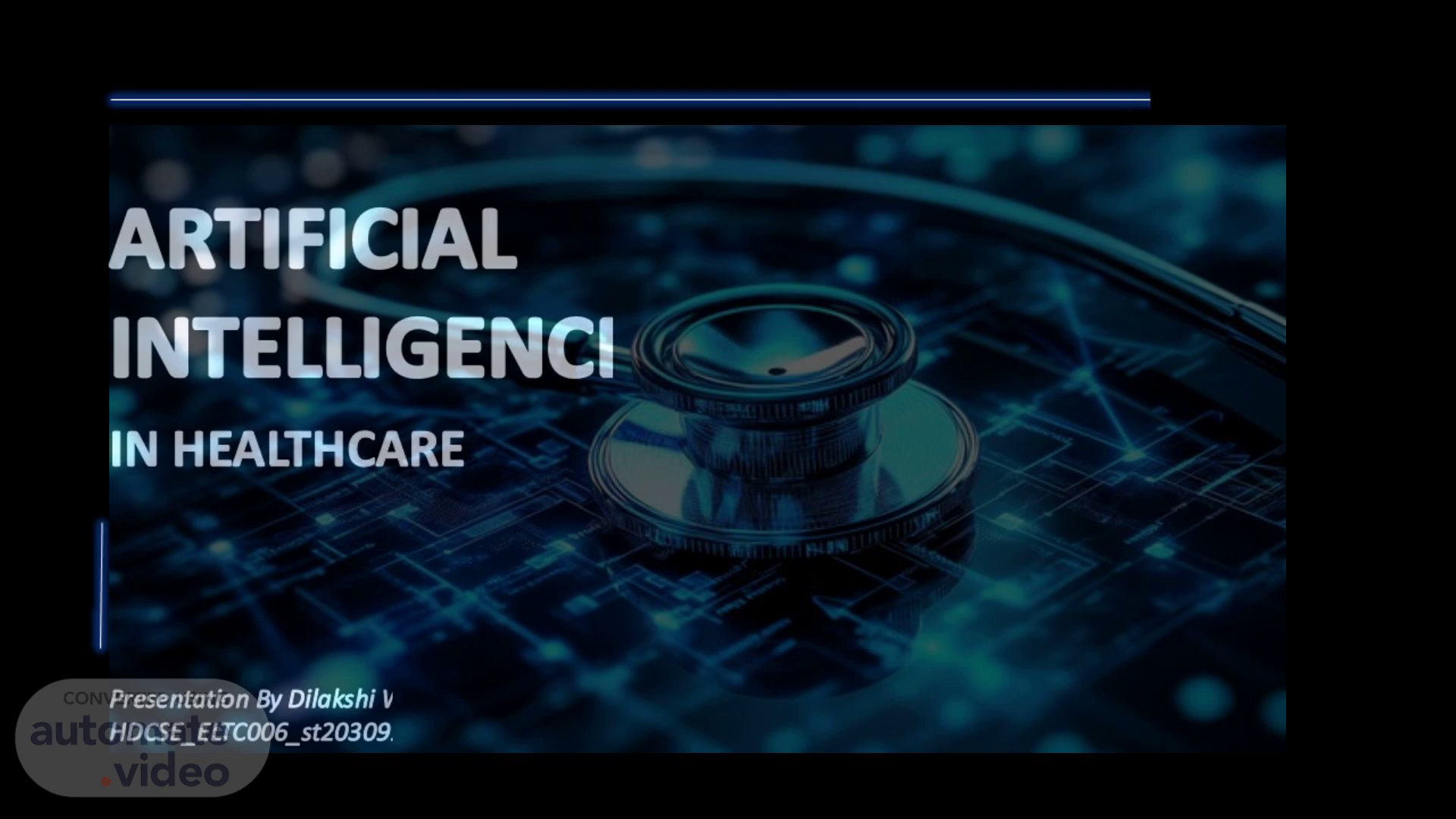Scene 1 (0s)
ARTIFICIAL INTELLIGENCE. IN HEALTHCARE. Presentation By Dilakshi Wijemanna HDCSE_ELTC006_st20309102.
Scene 2 (8s)
LIST OF CONTENT. [image] .51. 1. INTRODUCTION. 2.CURRENT APPLICATIONS.
Scene 3 (24s)
1.INTRODUCTION. Artificial intelligence (AI) is having a profound impact on the healthcare sector, causing a paradigm change. Artificial Intelligence (AI) uses complex algorithms and data analysis to spur innovation, allowing healthcare systems to maximize the quality of patient care through technological improvements. Healthcare practitioners may optimize workflows and give individualized treatment alternatives while improving efficiency, accuracy, and resource management by leveraging AI's capabilities. Doctors were able to engage with Covid patients and monitor their progress in terms of health thanks to the AI-powered robots. This eliminated the requirement for direct human contact with the patients, lowering the possibility of the illness spreading. This presentation explores how AI is reshaping the industry, from enhancing precision medicine to driving efficiencies in healthcare delivery.
Scene 4 (56s)
KEY MILESTONES IN AI DEVELOPMENT IN HEALTHCARE. [image].
Scene 5 (1m 16s)
2.Current applications of AI in Healthcare. Diagnostics AI improves diagnostic precision by examining medical images and spotting patterns that are difficult for human eyes to notice. Example : DeepMind at Google has created an AI system that can accurately diagnose more than 50 eye disorders with a degree of expertise..
Scene 6 (1m 37s)
Treatments By customizing therapies based on each patient’s unique genetic profile , AI helps customized medicine Example : The Da Vinci robot let surgeons perform precise minimally invasive treatments in robotic surgery ..
Scene 7 (1m 51s)
Patient Management Virtual health assistance with AI capabilities simplify patient interactions by managing everything from appointment booking to query resolution . Proactive care is made possible by predictive analytics , which aids in predicting patient decline . Example : IBM Watson for Oncology helps oncologists create personalized cancer treatment plans by analyzing patient data.
Scene 8 (2m 9s)
Careskore : AI App for patient care . It uses data to provide predictive insights , enhancing patient engagement and improve helath outcomes ..
Scene 9 (2m 30s)
3. Binah. ai Binah.ai uses the camera on smartphones to record vital signs like respiration and heart rate . This allows for remote monitoring and telehealth consultations, which improves accessibility to and ease of healthcare.
Scene 10 (2m 57s)
3. AI MEDICAL ROBOTS IN HEALTHCARE. “ Despite initial reluctance , AI Medical robots are now widely used in hospital settings . They help patients and automate repetitive chores , freeing specialists to work on more difficult projects . They provide precise , untiring performance that goes above and beyond human capabilities “.
Scene 11 (3m 22s)
2. The CyberKnife Robot Robotic system for precise radiation therapy . Treats tumors without surgery . Target to the Prostate , Head , Neck and Liver . Protects healthy tissues . Effective for Prostate Cancers.
Scene 12 (3m 42s)
4. BENEFITS OF AI IN HEALTHCARE. Improved Accuracy and Efficiency : AI improves patient outcomes by decreasing human error in diagnosis and treatment Cost Effectiveness : AI reduces the time it takes to develop new drugs and maximizes operating expenses in healthcare Accessibility : Through telemedicine and mobile health solutions , AI increases access to healthcare services in underserved and remote places.
Scene 13 (4m 10s)
5. ETHICAL AND REGULATORY CONSIDERATIONS. Data Privacy & Security : Protecting patient data is essential . It is imperative to adhere to the GDPR and other requirements . BIAS in AI Models : Biases in training data may be maintained by AI systems , resulting in unjust treatment outcomes. Regulation & Standards : Frameworks for the safe integration of AI in healthcare are being developed by the UK’s MHRA.
Scene 14 (4m 30s)
6. CHALLENGES AND LIMITATIONS. Technical Limitations : Large volumes of excellent data are needed for AI systems , as well as intricate integration with current healthcare systems Integration Issues : Hospital legacy systems make it difficult to integrate modern AI technologies Resistance to Adoption : Healthcare workers may be reluctant to use AI because they worry about losing their jobs.
Scene 15 (4m 51s)
7. FUTURE TRENDS AND OPPORTUNITIES. AI and Telemedicine : AI will improve virtual follow - ups and diagnostics , which will improve distant healthcare AI in Mental Health : AI techniques can improve mental health by using speech and text analysis to spot early indicators of problems AI and IoMT : AI enabled IoMT ( Internet of Medical Things ) will allow for real – time health analytics and ongoing patient monitoring.
Scene 16 (5m 12s)
8.CONCLUSION. AI has the potential to completely transform healthcare by enhancing patient care , diagnosis and treatment . Even while there are obstacles to overcome , there are a ton of possible advantages . To ensure its successful integration , ethical and regulatory considerations must be addressed ..
Scene 17 (5m 28s)
REFERENCES. Olawade, D.B., Wada, O.Z., Aderonke Odetayo, Aanuoluwapo Clement David-Olawade, Fiyinfoluwa Asaolu and Eberhardt, J. (2024). Enhancing Mental Health with Artificial Intelligence: Current Trends and Future Prospects. Journal of medicine, surgery, and public health, 3(3), pp.100099–100099. doi:https://doi.org/10.1016/j.glmedi.2024.100099. Third Rock Techkno. (n.d.). Role of AI in Healthcare: Impact, Benefits, Challenges & More. [online] Available at: https://www.thirdrocktechkno.com/blog/role-of-ai-in-healthcare/. Zhou, N., Zhang, C., Lv, H., Hao, C., Li, T., Zhu, J., Zhu, H., Jiang, M., Liu, K., Hou, H., Liu, D., Li, A., Zhang, G., Tian, Z. and Zhang, X. (2018). Concordance Study Between IBM Watson for Oncology and Clinical Practice for Patients with Cancer in China. The Oncologist, 24(6), pp.812–819. doi:https://doi.org/10.1634/theoncologist.2018-0255. Google.com. (2024). Flowchart illustrating AI’s role in patient management. - Google Search. [online] Available at: https://www.google.com/search?q=Flowchart+illustrating+AI%E2%80%99s+role+in+patient+management.&oq=Flowchart+illustrating+AI%E2%80%99s+role+in+patient+management.&gs_lcrp=EgZjaHJvbWUyBggAEEUYOdIBBzM3N2owajeoAgCwAgA&sourceid=chrome&ie=UTF-8 [Accessed 25 Sep. 2024]..
Scene 18 (6m 32s)
THANK YOU !. •li'lil. •.
